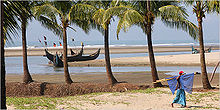| Cox's Bazar কক্সবাজার জেলা |
|
|---|---|
| District | |
| Cox's Bazar is the longest natural sea beach of the world | |
| Coordinates: 21.4500°N 91.9833°ECoordinates: 21.4500°N 91.9833°E | |
| Country | |
| Division | Chittagong Division |
| Area | |
| • Total | 2,491.86 km2 (962.11 sq mi) |
| Population (1991) | |
| • Total | 1,957,321 |
| • Density | 790/km2 (2,000/sq mi) |
| Literacy rate | |
| • Total | 21.9% |
| Time zone | BST (UTC+6) |
| • Summer (DST) | BDST (UTC+7) |
| Website | http://www.dccoxsbazar.gov.bd/ |
Contents
Geography
Often termed as the world's longest beach, Cox's Bazar has yet to become a major tourist destination in Asia.Cox's Bazar District has an area of 2491.86 km². It is located at 21°35′0″N 92°01′0″E and is bounded by Chittagong District on the north, Bay of Bengal in the south, Bandarban District on the east, and the Bay of Bengal on the west. Major rivers include Matamuhuri, Bakkhali, Reju Khal, Naf River, Maheshkhali channel and Kutubdia channel. The area of the city of Cox's Bazar is 6.85 km².
History
The history of Cox's Bazar begins in the Mughal period. On his way to Arakan, when the Mughal Prince Shah Shuja (1616–1660) passed through the hilly terrain of the present day Cox’s Bazar, he was attracted to the scenic and captivating beauty of the region. He commanded his forces to camp there. A place named Dulahazara, meaning "one thousand palanquins", still exists in the area.After the Mughals, the place came under the control of the Tipras and the Arakanese, followed by the Portuguese and then the British.
Cox's Bazar is named after Captain Hiram Cox, an officer of the East India Company, who was assigned with the charges of the current day Cox's Bazar and it's adjacent areas.[1][2]The town of Cox's Bazar was established in 1799 as a market town to honour Captain Cox. In 1854, Cox's Bazar was made a Sub Divisional headquarter in Chittagong district under the Bengal Presidency of British India.
After the end of British rule in 1947, Cox's Bazar remained a part of East Pakistan under the Dominion of Pakistan till 1971. Captain Advocate Fazlul Karim was the first chairman after independence from the British of Cox's Bazar municipality. He established the Tamarisk Forest along the beach to draw tourism to the town and to protect the beach from the tide. He donated many of his father-in-law's and his own lands to establish a public library and town hall. In 1971, the wharf was used as a naval port by the Pakistan Navy's gunboats. This and the nearby airstrip of the Pakistan Air Force were the scene of intense shelling by the Indian Navy during the Bangladesh Liberation War in 1971.
In the year 1984, Cox's Bazar was upgraded into a District from a Sub Division under the Chittagong Division.
Subdivisions
There are eight upazilas under this district, namely:- Chakaria Upazila
- Cox's Bazar Sadar Upazila
- Kutubdia Upazila
- Maheshkhali Upazila
- Ramu Upazila
- Teknaf Upazila
- Ukhia Upazila
- Pekua Upazila
Climate
The annual average temperature in Cox's Bazar is 34.8 °C and a minimum of 16.1 °C. The climate remains hot and humid with some seasons of temperate weather. The average amount of rainfall is 4285 nm.Economy and development
The major livelihood of Cox's Bazar district is tourism. Millions of foreign and Bangladeshi natives visit this coastal city every year. A number of hotels, guest houses, and motels have been built in the city and coastal region and the hospitality industry is a major employer in the area.A number of people are involved in the fishing and collection of seafoods and sea products. Oysters, snails, pearls and jewelry made from shells are popular with the tourists in the seaside and city stores. A number of people are also involved in the transportation business for tourists. Many people of the district are farmers.
In 2002, a surfing club was initiated at Cox's Bazar by a local Bangladeshi. It has now extended to holding an annual competition including locals and foreign tourists. This is the first surfing initiative in Bangladesh's history.
Religion
The district of Cox's Bazar consists 2300 mosques, 1200 Buddhist Temples, 700 churches and 400 temples.Places of interest
Cox’s Bazar, mostly famous for its beautiful sea beach and the sunset, has several other attractions, including:- Aggmeda Khyang,[3] a large Buddhist monastery, and a place revered by around 400,000 Buddhist people of Cox's Bazar Hill Tracts.
- Himchari, located about 8 km south of Cox's Bazar, is a picnic spot famous for its waterfalls and hill top from where a splendid view of the sea can be seen. Birds and animals roam near the road.
- Inani Beach has interesting rocks and coral bolders. It is 32 km from the main beach.
- Coxsbazar Circuit House, located 2 km from Laboni Point, has a good viewpoint. The ocean can be seen from a height, and one can also enjoy the view of Cox's Bazar city.
- St. Martin's Island, the only coral island in Bangladesh, is situated at 9 km south of Teknaf. It is a popular tourist spot.
- "'DULAHAZRA SAFARI PARK the only safari park in Bangladesh which is situated at Chakaria Upazila(চকোরিয়া). It has a wide range of exotic animals, bird, snake, water beast etc. It is one of the most affluent Safari Park of the world




